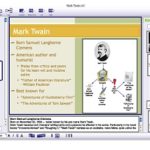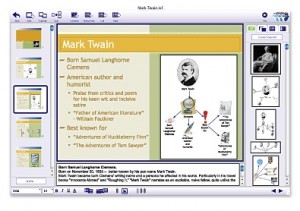
Software that takes a visual approach to teaching math has led to double-digit gains in the test scores of Orange County, Calif., students—and the software’s maker was one of several ed-tech companies demonstrating new visual learning products at the 2010 Florida Education Technology Conference (FETC) in Orlando.
At FETC, the nonprofit MIND Research Institute discussed findings of a 2009 study suggesting that students using the group’s ST Math software experienced dramatic learning gains.
ST Math is a supplemental program for students in grades K-5 that is based on decades of neuroscience research at the University of California, Irvine. The software taps into the brain’s innate “spatial temporal” reasoning ability to visualize and solve math concepts and problems, its makers say.
Students solve math problems presented as visual puzzles, before they are ever introduced to abstract math language and symbols. Through a carefully engineered sequence of fun-to-play software “games,” students work at their own pace to solve increasingly difficult problems that eventually require them to think multiple steps ahead in space and time—and they receive instant feedback about why a solution works or doesn’t.
More than 15,000 students enrolled in 64 elementary schools are taking part in the Orange County Math Initiative, a five-year community partnership involving Orange County schools, leaders in the business community, UC Irvine, and MIND. The 64 participating schools are in the lowest-performing 30 percent of California elementary schools; 80 percent of their students qualify for free or reduced-price lunches, and 60 percent are English-language learners.
Yet the percentage of these students who tested at the Proficient or Advanced level on California’s most recent state exam increased by more than 12 percentage points, MIND said, compared with the state average of 4.5 points.
“We’ve seen what can be done with the benefit of a tool like this,” said Andrew R. Coulson, president of MIND’s education division. Now, Coulson said, his organization is trying to make the software even better.
At FETC, the institute previewed its fourth generation of ST Math. Earlier versions of the software used a one-size-fits-all pacing, Coulson said; version 4 changes that, allowing educators to customize the pace and sequencing of lessons to better align them with whatever core curriculum their school is using.
Users can edit the software’s sequencing calendar with a drag-and-drop feature, and the new version includes pre- and post-tests to check students’ progress.
MIND also introduced a new math fluency program at FETC, called ST Math Fluency, that uses visualization strategies and interactive animations to reinforce basic math facts. To achieve optimal results, students should use the software programs for at least two sessions per week, Coulson said, with each session lasting 45 minutes.
Another company that makes visual learning programs for schools is Inspiration Software. At FETC, Inspiration debuted version 9 of its popular self-titled software, which helps students develop critical thinking and organizational skills through the use of visual representations. The program reportedly is used in more than 25 million schools worldwide.
Responding to a frequent request from teachers, Inspiration 9 adds new presentation capabilities to the software, said company president and co-founder Mona Westhaver. With just a few mouse clicks, students now can create a presentation from an outline they’ve constructed.
For schools that choose not to upgrade to the full version 9, a presentation applet that adds the same functionality is available for downloading. But Inspiration 9 adds several other new capabilities that are useful as well, Westhaver said.
These include the ability to add video and sound to outlines; a menu of choices for labeling how various concepts are linked in a concept map, making it easier for students to understand the relationships between concepts; and a new map view for creating Mind Maps, a method of note-taking in non-linear fashion developed by Tony Buzan in the 1970s.
A single copy of Inspiration 9 sells for $69, with volume and site licenses available. For schools upgrading from earlier versions of the software, the cost is $29.95 through June 30 and $39.95 thereafter.
For the past several years, Inspiration Software has offered grants for teachers to learn how to incorporate visual learning strategies in their classrooms. Applications for these Inspired Teacher Scholarships typically were due in late January, but this year the company didn’t issue a call for applications.
Westhaver explained that the company is restructuring the program to incorporate student projects, too—and the new grant program will be announced later this year.
- EPS Learning Programs Selected by Virginia Board of Education as Recommended Literacy Solutions - April 15, 2024
- Vernier Science Education Selects 10 Inspiring STEM Teachers to Join Its New Vernier Trendsetters Community - April 12, 2024
- Vivi for Teachers Launches to Bring Free Classroom Technology to Educators - April 11, 2024


Comments are closed.